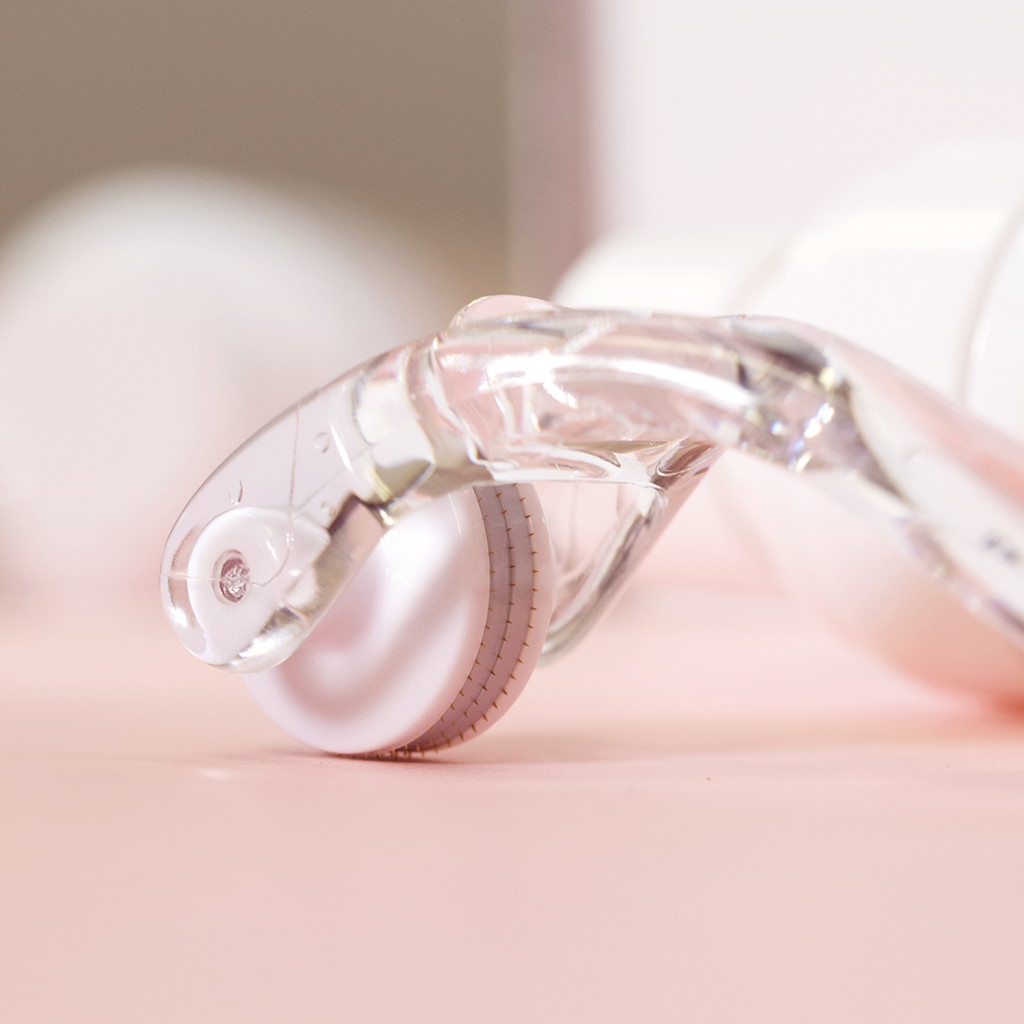Skin 101: How to Use a Derma Roller

Derma rolling is an at-home version of a microneedling treatment with many benefits when practised correctly. Affordable and convenient, learning how to use a derma roller at home can help to support in-clinic treatments and give you glowing, healthy skin.
Unsure where to start when it comes to derma rolling at home? We’ve got you!
P.S Don't forget you can use your member-only discount to purchase one for yourself!
What is derma rolling?
Also known as at-home microneedling, derma rolling involves using a small handheld device featuring a roller covered in very fine needles. These needles create tiny pinpricks in the skin, causing a very low-level trauma to the outer layer of the skin. We promise it isn’t as scary as it sounds! The needles trigger the body’s natural wound healing response, stimulating collagen and elastin production. It’s considered a minimally invasive procedure with a fairly speedy recovery time, especially with shorter needles.
The benefits of derma rolling
Derma rolling has many benefits, the main one being collagen and elastin production. This is important because these are the two ‘building blocks’ of healthy skin, resulting in stronger, smoother skin.
Evens skin texture
Bumpy or uneven textured skin can be improved with derma rolling and skincare.
Helps reduce acne scarring
One of the key benefits of derma rolling and microneedling can be reducing the appearance of acne scars. While shallow acne scars and pigmentation caused by minor breakouts can be treated with a derma roller, for more severe acne scarring or deeper scars, in-clinic treatments are recommended. Read more about acne scar treatments that actually work.
Improves the look of fine lines and wrinkles
Boosting collagen and elastin in the skin helps to plump up and ‘fill in’ fine lines and wrinkles. It can also help to restore firmness and tightness, thickening and strengthening ageing skin.
Helps penetration of skincare
Another major benefit of derma rolling is that by opening very fine channels in the skin, it allows any skin care products you apply afterwards, like moisturiser, eye cream, and anti-ageing skincare to absorb better and work more effectively.
Reduces the appearance of enlarged pores
Stimulating collagen production by derma rolling can cause the collagen in the skin and around the pores to plump up and as a result, pores to appear smaller.
Helps to break up pigmentation and uneven skin tone
Derma rolling and microneedling encourage skin cell regeneration which can lighten dark spots and work to break up the pigmentation. You may need in-clinic treatments to effectively and quickly reduce pigmentation, but derma rolling can help to prolong and maintain your results.
At-home derma rolling vs In-clinic Microneedling

The difference between a clinical microneedling (Collagen Induction Therapy) treatment and an at-home version such as derma rolling is that the needles on a derma roller are much smaller than those used in clinic. At Caci we also combine our microneedling treatments with electroporation to allow a tailored serum to absorb deeper into the skin. In-clinic treatments tend to garner better results, especially for deeper acne scars and pigmentation.
Home rolling, on the other hand, is a great way to support your in-clinic treatments and the effects of your skincare products, achieving long-lasting results over time.
Derma rolling needle sizes

There are different needle lengths and roller sizes available to treat areas of the face, neck and décolletage. At Caci, we sell derma rollers in NZ in the following sizes:
Mini Derma Roller 0.3mm
The Skinsmiths 0.3 mini derma roller has the shortest needle length and is great for use on delicate areas around the eyes and nose. It has a narrower roller to get into the nose area.
Standard Derma Roller 0.3mm
This Skinsmiths 0.3mm derma roller is a game-changer and the perfect place to start if you are using a derma roller at home for the first time.
Advanced Derma Roller 0.5mm
If you’ve been using your 0.3mm derma roller and your skin is well adapted to it, you can look to level up your at-home rolling with a Skinsmiths 0.5mm Derma Roller for your face, neck and décolletage.
How to use a derma roller at home
Learning how to use your derma roller properly is important to avoid skin damage and unwanted infections.
To use your 0.3mm or 0.5mm roller on your face and neck, follow these instructions carefully
Step 1. Disinfect your roller
Disinfect your derma roller by soaking it in 70 percent isopropyl alcohol or by using your Skinsmiths sanitising spray. Spray your roller three times or soak to ensure it is properly coated and leave for 10 minutes to dry.
Step 2. Clean skin and hands thoroughly
Thoroughly clean your face and neck using a gentle cleanser, and ensure hands are clean before you begin.
Step 3. Divide your face into sections
Standing in front of a mirror, imagine your face divided into sections; within these sections, roll the area in a grid pattern. This will ensure you treat all areas of the face/neck. Avoid lips and eyes.
Step 4. Begin derma rolling your face
Hold the skin tight and in small sections, roll back and forth 4-5 times applying gentle pressure to begin with. Then, lift the roller and change direction: roll up and down, diagonal one way, then diagonal the other, as if you were making an asterisk shape - lifting the roller off the skin with every change in direction. Repeat over each section of your face.
Step 5. Derma roll your neck and décolletage
If you would like to treat your neck and décolletage, follow step 4, holding the skin tight and working in small sections.
Step 6. Apply serum and moisturiser
After rolling, micro-channels in the skin will have been opened up, so it’s the perfect time to treat your skin with serums, followed by moisturisers. Avoid serums that contain active ingredients like vitamin c and retinol and chemical exfoliates, and reach for hyaluronic acid serums to help the skin repair.
Step 7. Clean and sanitise your roller
Clean your derma roller with dishwashing soap to help to dissolve the proteins found in the skin. Create a soapy water mix in a container and swish the roller vigorously, making sure the roller doesn’t hit the sides. Rinse your roller with clean water then sanitise with alcohol or sanitising spray and leave to dry fully before storing it back in the protective case.
How to use a derma roller around the eyes and noseThe skin around the eyes and nose is delicate and requires a light hand a bit of know-how.
Use a 0.3mm mini roller and follow instructions carefully.
Step 1. Disinfect your roller
Disinfect your derma roller by soaking it in 70 percent isopropyl alcohol or by using your Skinsmiths sanitising spray. Spray your roller three times or soak it to ensure it is properly coated and leave for 10 minutes to dry.
Step 2. Clean skin and hands thoroughly
Thoroughly clean your face and neck using a gentle cleanser, and ensure your hands are clean before you begin.
Step 3. Derma Rolling the eye area
It is important not to roll past the bone of the eye socket or below your eyebrows. Before you start, use your finger to trace the bone around your eye - you can use a makeup pencil to help ensure you don't roll too close.
Hold the skin tight, in small sections, roll back and forth 4-5 times. Then, lift the roller and change direction: roll up and down and diagonal one way then the other, repeat over each section.
Step 4. Derma rolling around the nose
Gently hold your nose to one side so that your mini roller can get to the area. In small sections, roll back and forth repeating Step 3.
Step 5. Apply serum and moisturiser
After rolling, micro-channels in the skin will have been opened up, so it’s the perfect time to treat your skin with serums, followed by moisturisers. Avoid serums that contain active ingredients like vitamin c and retinol and chemical exfoliants, and reach for hyaluronic acid serums to help the skin repair.
Step 6. Clean and sanitise your roller
Clean your derma roller with dishwashing soap to help to dissolve the proteins found in the skin. Create a soapy water mix in a container and swish the roller vigorously, making sure the roller doesn’t hit the sides. Rinse your roller with clean water then sanitise with alcohol or sanitising spray and leave to dry fully before storing it back in the protective case.
For best results, start by using once a week and then slowly increase as recommended by your Treatment Provider. Roll for no longer than 2 minutes in total. After rolling, follow with a serum to suit your skin concerns, then moisturiser.
How often should you use a derma roller?
For best results, start by using a derma roller once a week and then slowly increase as recommended by your Treatment Provider. Roll for no longer than 2 minutes in total. After rolling, follow with a serum to suit your skin concerns, then moisturiser. Always make sure your skin is completely recovered before starting another session.
Do you put serums on before or after derma rolling?
Serums and moisturisers are most effective when used after derma rolling, as microchannels have been opened up and products can absorb better and penetrate deeper into the skin.
Do’s and don’t of derma rolling
Derma rolling, when done correctly and hygienically, is safe and can give you some great results. Follow these do’s and don’ts for safe derma rolling at home.
Do read and follow product instructions carefully, starting slowly. If you’re a Caci member, chat to your skincare expert who can talk you through the steps and ensure you are comfortable with the technique before you try it at home.
Do start slow by using your roller just once a week, to allow your skin time to adjust and heal.
Do make sure to always keep your roller clean to avoid the risk of infection. You should replace your derma roller after a few months (depending on how often you use it and how it is looked after). Keep a keen eye out for any signs of damage on your roller and do not use it if you see any.
Do make sure to always use sunscreen during the day after derma rolling. It’s also best to avoid tanning oils and tanning waters for a couple of days after.
Don’t use active ingredients such as vitamin C or retinol immediately after rolling or while your skin is still feeling sensitive. and while home rolling it’s essential to use sunscreen during the day and avoid using any products with strong active ingredients immediately afterwards, such as retinol or Vitamin C.
Don’t use your roller if your skin is irritated or infected, or if you have active acne or rosacea. If signs of irritation appear, rinse skin with water and discontinue use before consulting with your Caci Therapist
Don’t use your derma roller on eyelids or lips as the skin is too delicate and thin.
Don’t share your derma roller. Your roller should be for your use only.
Try Derma Rolling and Microneedling with Caci
For more in-depth advice about derma rolling, we’d recommend popping in for a free consultation at your nearest clinic. Book a free consultation to shat to a skincare expert about your desired results and get a tailored recommendation about the best treatment options for you. Feel confident in your skin with Caci.



